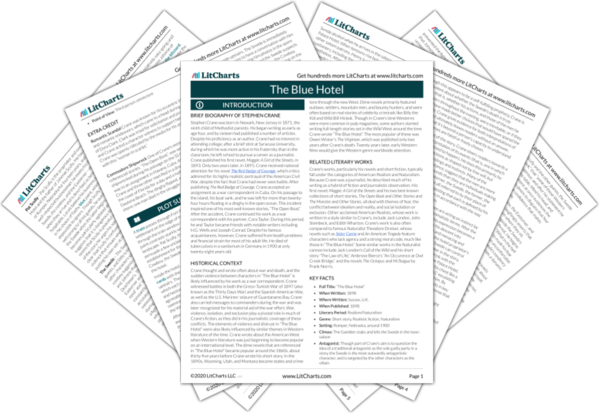In “The Blue Hotel,” the color blue is symbolic of temptation and lawlessness. The blue hotel, called the Palace but known primarily by its color, stands in stark contrast to the environment surrounding it because of its light blue paint. Foreigners gaze upon the hotel with “shame, pity, [and] horror,” yet no train traveler can pass by the hotel “without looking at it.” These details demonstrate the garishness of the hotel, which those from more urban, “civilized, destinations than Romper see as gaudy yet deeply intriguing. The hotel’s eye-catching color suggests it as a place apart from the normal rules and regulations of society, a place where anything may happen. It is no wonder, then, that it is within the walls of the blue hotel that the Swede grows increasingly paranoid about his companions and begins to engage in odd behavior that ultimately spurs the group to violence.
Crane also uses the color blue to describe the blizzard. He writes, “Through the windows could be seen the snow turning blue in the shadow of dusk.” The increasingly blue landscape, which mirrors the pale blue of the hotel, suggests that lack of self-control and inappropriate behaviors formerly present only inside the hotel are eventually pushed outside into the “blue” storm, creating a similarly volatile environment in the world beyond the building’s walls. The hotel may appear to be a lawless place distinct from society, yet what happens inside the does not stay there.
Blue Quotes in The Blue Hotel
The Palace hotel at Fort Romper was painted a light blue, a shade that is on the legs of a kind of heron, causing the bird to declare its position against any background. The Palace Hotel, then, was always screaming and howling in a way that made the dazzling winter landscape of Nebraska seem only a gray swampish hush. It stood alone on the prairie, and when the snow was falling the town two hundred yards away was not visible. But when the traveler alighted at the railway station he was obliged to pass the Palace Hotel before he could come upon the company of low clapboard houses which composed Fort Romper, and it was not to be thought that any traveler could pass the Palace Hotel without looking at it. […] It is true that on clear days, when the great transcontinental expresses, long lines of swaying Pullmans, swept through Fort Romper, passengers were overcome at the sight, and the cult that knows the brown-reds and the subdivisions of the dark greens of the East expressed shame, pity, horror, in a laugh.

Unlock explanations and citation info for this and every other The Blue Hotel quote.
Plus so much more...
Get LitCharts A+The Swede backed rapidly toward a corner of the room. His hands
were out protectingly in front of his chest, but he was making an obvious struggle to control his fright. “Gentlemen,” he quavered, “I suppose I am going to be killed before I can leave this house. I suppose I am going to be killed before I can leave this house!” In his eyes was the dying-swan look. Through the windows could be seen the snow turning blue in the shadow of dusk. The wind tore at the house, and some loose thing beat regularly against the clapboards like a spirit tapping.
No snow was falling, but great whirls and clouds of flakes, swept up from the ground by the frantic winds, were streaming southward with the speed of bullets. The covered land was blue with the sheen of an unearthly satin, and there was no other hue save where, at the low, black railway station—which seemed incredibly distant—one light gleamed like a tiny jewel.












